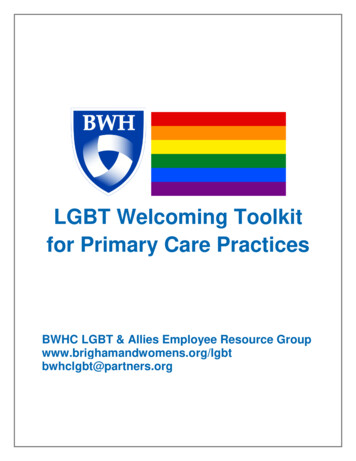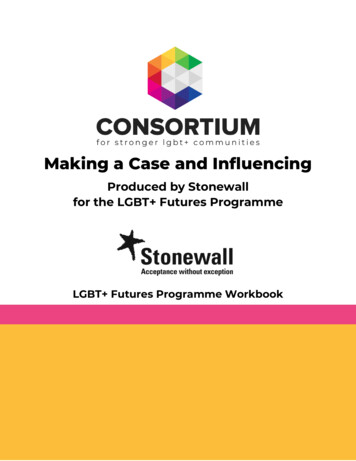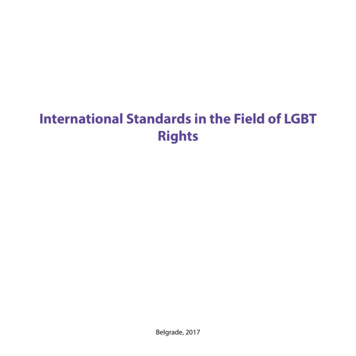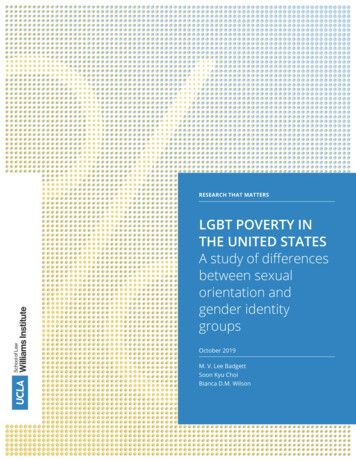
Transcription
LGBT Welcoming Toolkitfor Primary Care PracticesBWHC LGBT & Allies Employee Resource s.org
Message from the BWHC LGBT & Allies ERG BoardEXECUTIVE SPONSORSMichael Gustafson, MD, MBAPresident, BWFHErin McDonough, MBAVP Communication andPublic Affairs, BWHERG CO-CHAIRSHarry Reyes NievaPrimary Care, BWHCPothik Chatterjee, MBAStrategic Planning, BWPOEDUCATION &ADVOCACY CHAIRW. Emily Leung, MSGeneral Medicine, BWHCOMMUNICATION &PUBLIC AFFAIRS CHAIRMeredith Solomon, MLSMedical Library, BWHOur LGBT Welcoming Toolkit aims to help the BWHC primarycare practices meet the needs of their lesbian, gay, bisexual,and transgender (LGBT) patients by delivering high quality,patient-centered care. Generally speaking, one in twentypatients identifies as L, G, B or T. Do you consider your practiceparticularly welcoming to members of the LGBT community?In this toolkit you will find information about our LGBT & AlliesEmployee Resource Group, a glossary of terms, a checklist togauge just how welcoming and inclusive your practice mightbe, information about ways to signal to LGBT patients that youwant to meet their needs, tips on gathering information aboutsexual orientation and gender identity from patients and storingthat information in eCare, and common stumbling blocks ormisconceptions that even those with the best of intentions mayunconsciously commit or have. We also point you to otherresources about LGBT health and care for LGBT patients.SOCIAL EVENTS CHAIRJoeli Katz, MAWomen’s Health, BWHThis toolkit is very much a living document that willcontinue to grow. We encourage you to provide us withyour feedback. You can easily share your thoughts via ouranonymous web-based MEMBER-AT-LARGEThomas B. AndersonMarketing, BWPOPlease feel free to reach out to us with any questions youmay have. We are here to help.Proudly,The BWHC LGBT & Allies Employee Resource Groupreleased 20 May 2016BWHC LGBT & Allies Employee Resource Group1
Table of ContentsMission of the BWHC LGBT & Allies ERG . 3Glossary of Terms and Concepts . 4Checklist for an LGBT Welcoming Clinic . 5Rainbow Stickers, Flags, and Decals . 6Listing “LGBT health” and “transgender care” among clinical interestsin the provider directory . 75 Tips for Gathering Sexual Orientation and Gender Identity (SO/GI)Demographics in the Clinical Setting . 8Top 5 Reasons to Collect Sexual Orientation and Gender Identity (SO/GI)Demographics in eCare . 9Common Stumbling Blocks for Providers . 10Myths and Misconceptions . 11Selected Resources . 12BWHC LGBT & Allies Employee Resource Group2
Mission of the BWHC LGBT & AlliesEmployee Resource GroupEstablished in 2008, the Brigham and Women’s Health Care LGBT & Allies Employee ResourceGroup (ERG) seeks to create a welcoming and affirming environment for Lesbian, Gay,Bisexual and Transgender employees, patients, families and friends.We accomplish this mission through the following means: Increasing visibility, awareness, and understanding of LGBT individuals and issueswithin all levels and aspects of the organization Educating providers and staff about the unique health and mental health care needs ofLGBT patients and families Providing advocacy and support to BWHC employees with an interest and expertise inLGBT issues in the form of recruitment, mentorship, professional development, andaccess to benefits and resources Ensuring that all BWHC policies are LGBT-inclusive and that staff, employees, andpatients are aware and educated about these Offering support, networking opportunities, and camaraderie among employees and staffat BWHC who are lesbian, gay, bisexual, transgender, and alliesBWHC LGBT & Allies Employee Resource Group3
Glossary of Terms and ConceptsThese definitions were adapted and expanded from those developed by consensus of theAssociation of American Medical Colleges Advisory Committee on Sexual Orientation, GenderIdentity, and Sex Development and presented in AAMC’s publication, Implementing Curricularand Institutional Climate Changes to Improve Health Care for Individuals Who Are LGBT,Gender Nonconforming, or Born with DSD. They are provided with the understanding that theyare not meant to replace conversations with patients about sexual orientation, sexual practices,gender, etc.SEXUAL ORIENTATION: an individual’s inclination to feel sexual attraction or arousal to aparticular body type or identity.Bisexual: usually refers to a person who has a sexual attraction to both males and females.Gay: usually refers to a person who identifies his or her primary romantic feelings, sexualattractions, and/or arousal patterns as being toward someone of the same gender or sex.Homosexual: literally “same-sex,” usually used as an adjective to refer to same-gendered relations.Lesbian: usually refers to a female person who identifies her primary romantic feelings, sexualattractions, and/or arousal patterns as being toward a person of the same gender or sex.Pansexual: usually refers to a person who identifies his or her primary romantic feelings, sexualattractions, and/or arousal patterns as being toward any person, without regard to gender or sex.Straight/Heterosexual: literally “other sex” or “different sex,” usually used as an adjective to refer torelations between a man and a woman.Queer: a term available for patients to use in self-identifying their sexual orientation and/or gender.ASSIGNED SEX AT BIRTHSex: the aggregate of an individual’s biological traits (genotypical and phenotypical) as those traitsmap to male/female differentiation and the male-female anatomical and physiological spectrum (seealso “natal sex”).Natal Sex: usually refers to the sex karyotype (XX, XY, XO, XXY, etc.) and sex phenotype (externalgenitals, gonads, internal sex organs) with which a person was born. Natal sex is typically what isused to give a baby a gender assignment as boy or girl.Intersex: historically, a term used in biology and, later, in medicine to refer to beings (includingpeople) whose sex development falls between the male-typical and female-typical forms. The use ofthe term as an identity label is currently in flux;Difference of Sex Development (DSD): an emerging umbrella term for a wide variety of congenitalconditions in which the development of chromosomal, gonadal, and/or anatomical sex is atypical.GENDER IDENTITY: an individual’s personal and subjective inner sense of self as belonging toa particular gender.Gender: psychological, behavioral, and cultural characteristics that are believed to be associatedwith maleness and femaleness.Gender Expression: mannerisms, personal traits, clothing choices, etc., that serve to communicatea person’s identity as they relate to a particular societal gender role.Genderqueer: an umbrella category for people whose gender identities are something other thanmale or female. People who are genderqueer may identify as: having an overlap or indefinite linesbetween gender identity and sexual and romantic orientation; being two or more genders; beingwithout a gender; or moving between genders or having a fluid gender identity.Trans Female-to-Male (FtM): usually refers to a transgender person who was identified as femaleat birth but who identifies as a male in terms of his gender identity.Trans Male-to-Female (MtF): usually refers to a transgender person who was identified as male atbirth but who identifies as a female in terms of her gender identity.BWHC LGBT & Allies Employee Resource Group4
Checklist for an LGBT Welcoming ClinicIntake and Record-keeping My intake forms differentiate between birth sex and current gender OR includetransgender options (like MTF/trans-woman and FTM/trans-man) OR allow openresponse (like “other”). In eCare, this information can be stored in the Medical Historysection of a patient’s chart. If applicable, my intake forms include “domestic partnership” and/or “partnered” inaddition to options like single/married/widowed/divorced. I know how to address a patient’s concerns about the inclusion of sexual identity inpaper or electronic health records.Clinic Environment Our non-discrimination policy is visible and includes sexual orientation and genderidentity. I enforce my institution’s policy on treatment of sexual minority patientsand employees. My office provides and displays some educational materials that are either LGBTinclusive or LGBT-specific.Linguistic Sensitivity My medical and non-medical staff understand that families come in many differentshapes. When we interact with patients, our language non-presumptively conveys thisunderstanding.My medical and non-medical staff understand how to use a transgender patient’spreferred pronouns.When I ask about a patient’s intimate relationships, I begin with non-presumptivequestions like “Who lives with you?” and “Are you in a relationship?” rather than “Are youmarried?” and “Do you have a boyfriend?”My interviewing technique reflects that sexual orientation, sexual behavior, and genderidentify cannot be predicted from one another.Clinical Practice I can provide appropriate safe sex advice and immunizations based on a patient’ssexual orientation and behaviors. I understand LGBT cancer risks and other health disparities and provide appropriatescreening. I know what screenings to provide transgender patients who are transitioningor have transitioned surgically. I know why advance directives are particularly important to non-heterosexual couples,and I counsel these patients to get the important protections that advance directives canprovide. I understand and can explain family planning options that are available to same-sexcouples. With transgender patients, I can distinguish between medical issues that are within myscope of practice and those that are outside my scope of practice, and I do notneedlessly refer these patients away. I can locate community resources that are particular to or inclusive of LGBT persons andtheir health needs, like smoking cessation programs or Alcoholics Anonymous.BWHC LGBT & Allies Employee Resource Group5
Rainbow Stickers, Flags, and DecalsThe rainbow flag has long been used by the LGBT community as a symbol of LGBT prideand LGBT social movements. The colors reflect the diversity of the LGBT community and therainbow symbol is often used in Pride parades and LGBT civil rights marches. It isrecognized worldwide. Many retail shops or restaurants, for example, display rainbow flagson their windows to signal that they are LGBT welcoming.While the rainbow flag is universally recognized as a symbol of the LGBT community, keep inmind that the transgender community also has a separate flag that consists of five horizontalstripes: two light blue, two pink, and one white in the center.LGBT flagTransgender flagRainbow stickers can be placed on your (as well as all your staff’s) badges so that they areconveniently displayed to patients with whom you interact, and office decals can be visiblyplaced throughout the clinic such as on doors and by reception to promote a welcomingenvironment for LGBT patients.BWHC employees can obtain rainbow stickers at the BWH Medical Library and BWFH HumanResources office. Staff can also email bwhclgbt@partners.org to request rainbow stickers.BWHC LGBT & Allies Employee Resource Group6
Listing “LGBT health” and “transgender care” amongclinical interests in the provider directoryWhile most health issues affecting LGBT individuals are similar to those of the generalpopulation, we know that LGBT people have unique health needs and experience disparities incare. For years staff and patients at our sites have reached out to the BWHC LGBT & AlliesEmployee Resource Group (ERG) to help them identify providers who are trained andcompetent in meeting the health needs of LGBT patients. Indeed, our own physician referralservice has asked the ERG for assistance in this regard.As members of the ERG, one of our goals is to raise awareness and identify best practices forcreating a welcoming environment for our LGBT patients. In an effort to achieve this goal and toprovide more focused, patient-centered care to our LGBT patients, we encourage providers whomeet the following criteria to list “LGBT health” and/or “transgender care” among their clinicalinterests in the provider directory. LGBT patients very often use the provider directory to identifyproviders who are LGBT welcoming and knowledgeable about LGBT health.Clinical Interest: LGBT Health1) Regularly cares for LGBT patients2) Is knowledgeable about the unique and specific health needs of the LGBT community3) Has participated in training or education in LGBT health (CME, LGBT lectures,conferences, etc.)Clinical Interest: Transgender Care1) Regularly cares for transgender patients2) Is knowledgeable about the unique and specific health needs of the transgendercommunity3) Has participated in training or education in transgender care (CME, LGBT lectures,conferences, etc.)BWHC LGBT & Allies Employee Resource Group7
5 Tips for Gathering Sexual Orientation and GenderIdentity (SO/GI) Demographics in the Clinical SettingAs of Group 1 go-live on May 30, 2015, Partners eCare and the new Epic-based electronichealth record system provides a standardized method for voluntary collection of sexualorientation and gender identity (SO/GI) demographics as part of a clinical visit. The collectionof this clinical data at the discretion of both patient and provider is intended to enhance theprovider’s ability to understand their patient and provide patient-centered care.Tip 1. Be open, kind, and respectfulPatients want to be visible but may also feel particularly vulnerable disclosing information aboutsexual orientation and gender identity. They may be concerned that it will not be keptconfidential or will be somehow used against them. Fostering a respectful rapport andexplaining the health care reasons for asking these questions is key to ensuring the exchangeof information that high quality health care requires. Utilizing basic principles of culturalcompetence – empathy, curiosity, and respect – can facilitate the disclosure of sensitiveinformation that is crucial to high quality patient-centered health care.Tip 2. Discuss sexual orientation and gender identity as part of a thorough medical andsexual historyPartners eCare electronic health record provides a standardized method for collection of sexualorientation and gender identity demographics as part of a clinical visit. The collection of this dataenhances a provider’s ability to understand their patient and provide patient-centered care.Providers should ensure their patients feel comfortable with self-disclosure by initiating arespectful dialogue in private and articulating that all standards of patient privacy andconfidentiality will be met.Tip 3. Don’t make assumptions; ask open questions Sexual orientation is self-identified and the documentation should reflect the patient’s selfidentified sexual orientation. When taking a sexual history, ask neutral questions (e.g. do you have sex with women, menor both?) but remember that sexual behavior is distinct from sexual identity. Both areimportant for medical care, however the demographics section referenced here is fordocumentation of sexual identity only, not specific sexual behavior. Avoid assumptions of gender based on appearance. Ask patients how they identify, whattheir preferred name is, and what pronouns they prefer to use. Document preferred names and pronouns and be sure to use them in all interactions.Tip 4. Apologize promptly for any mistakesThere is a learning curve to becoming skilled at having these conversations. You may feeluncomfortable or awkward at first. You may make mistakes. If this happens, apologize promptlyand make the necessary corrections to ensure it doesn’t happen again.Tip 5. Seek out additional education as necessaryIf you encounter a situation where you are not sure what the best course of action is, seek outadditional training and necessary resources. All patients deserve high quality health care thatmeets their unique needs. For additional resources, go to www.lgbthealtheducation.org. If youhave any questions related to collection of sexual orientation and gender identity in eCare,please send questions to sogiecare@partners.org.
Top 5 Reasons to Collect Sexual Orientation andGender Identity (SO/GI) Demographics in eCare1. High Quality, Patient-Centered Health CareAll patients deserve to have health care that identifies and meets their specific needs.1A large national study of patients in four health centers across the United States demonstratedoverwhelming support for the inclusion of SO/GI demographics in the medical record. Patientsarticulated understanding the need for this information to be accurately collected anddocumented in the medical record.2Individual clinicians or practices may already collect these data however this is a newopportunity to standardize the methods for collection, creating a repository of accessibleinformation which facilitates the identification and subsequent remediation of disparities.2. Alignment with key recommendationsKey recommendations in Healthy People 2020, the 2011 the Institute of Medicine report onLGBT health issues and research gaps, the Joint Commission’s LGBT Field Guide, and thefederal government’s implementation of the Patient Protection and Affordable Care Actencourage the collection of sexual orientation and gender identity as a means toward reducingLGBT health disparities.33. Cutting Edge ResearchSignificant documented health disparities affect LGBT people. Including sexual orientation andgender identity among the collected patient demographics will allow us to better quantify andunderstand those disparities. Better understanding of disparities will support better health carefor all.44. Partners institutions are leaders in LGBT Healthcare EqualityThe move toward collection of sexual orientation and gender identity data reflects our nationalleadership in healthcare delivery.5. It’s the right thing to do!1Wimberly, YH, Hogben, M, Moore-Ruffin, J, Moore, SE, Fry-Johnson, Y. Sexual history-taking among primary care physicians.Journal of the National Medical Association. 2006; 98: 1924-1929; Dahan, R, Feldman, R, Hermoni, D. Is patient’s sexual orientationa blind spot of family physicians? Journal of Homosexuality. 2008. 55: ploads/COM228 SOGI CHARN ointcommission.org/assets/1/18/LGBTFieldGuide WEB LINKED les/docs/the aca helps lgbt americans.pdf4Healthy People 2020. Lesbian, gay, bisexual, and transgender ectives/overview.aspx?topicid 25; Mayer KH, Bradford, JB, Makadon HJ, Stall, R,Goldhammer H, Landers S. Sexual and gender minority health: What we know and what needs to be done. American Journal ofPublic Health. 2008: 98: 989-995BWHC LGBT & Allies Employee Resource Group9
Common Stumbling Blocks for ProvidersEven healthcare providers who are familiar with the unique issues of sexual and gender minoritiesmake mistakes. Professionals at every level of cultural competency often request advice about whatstumbling blocks to avoid. Below, we identify some of the most common and most problematicstumbling blocks that may come up in your patient interactions.Using inappropriate clinical reasoning once a patient’s sexual minority status is knownA gay man who has had the same exclusive sex partner for twenty years does not require aheightened scrutiny of HIV if both were tested in recent years. Likewise, gonococcus should notautomatically replace streptococcus as the most suspected cause of bacterial pharyngitis in WSWuntil the history of sexual behaviors suggests otherwise.Over-identifying on the basis of having friends or family who are gay or lesbianDo not be too eager to bring up your gay friend/son/sibling. Among other things, this can come off assaying, “If I know one of you, I know all of you.”Mentioning the “homosexual lifestyle,” calling sexual orientation a “preference,” andavoiding sexual and gender minority terminologyThe terms “homosexual lifestyle” and “sexual preference” are likely to be interpreted as hostile.Similarly, avoiding the word “gay” when the patient self-identifies as gay can easily be interpreted asdisinterest or rejection. It is usually effective to repeat back the term the patient uses.“I treat all of my patients the same.”This sounds like an assertion that the status quo should be satisfactory for sexual and genderminorities. Many would disagree. It also implies that you think that you do not need to know muchabout patients in order to treat them.Failing to recognize intimate partner violence in same-sex couplesIntimate partner violence occurs in same-sex couples—it is more prevalent in gay men than thegeneral population and less prevalent in lesbian women than the general population. On the whole,physicians are worse at recognizing an abusive dynamic of power and control when the perpetratoris not a man and the victim is not a woman. Be prepared to screen for intimate partner violence in allrelationships.Assuming that transgender persons want to be teaching opportunitiesMany transgender persons are happy to be involved in education of professionals, but aphysician’s excitement about sharing a rare opportunity can easily lead to an unwanted andinvasive-feeling parade of white coats.Failing to vocalize to LGBT patients that they do not deserve abuse or victimizationSexual and gender minorities are used to being told that mistreatment is their fault. Acknowledgingthat mistreatment is not deserved is essential for creating rapport. For all patients, it is important toaffirm, “You do not deserve to be treated like this.”“Which one of you is the real mother?”When same-sex partners are raising children, it is preferable to ask which is the biological mother orfather. However, just as with opposite-sex couples, it should also not be presumed that either of twoparents is biologically related to a child.“I have to ask -- do you have sex with men, women, or both?”While it is good to normalize questions about sensitive topics like sexual behavior, expressingreluctance is unlikely to make the patient feel comfortable and less likely to uncover medically usefulinformation. A better way of normalizing is to use a variation on “I ask all my patients ”BWHC LGBT & Allies Employee Resource Group10
Myths and Misconceptions Transvestitism (cross-dressing) is an indication that someone is transgender.While transgender people often dress differently to bring their gender expression in line with theiridentity, cross-dressing is often seen in non-transgender (cis-gender) persons and in performancestyles like drag and many theatre traditions. Transgender people want hormone therapy and to eventually complete surgery.Some are satisfied after changing their gender expression; others are satisfied with hormonetherapy. If someone identifies as gay or lesbian, I can assume he or she has been sexually activeonly with members of the same sex.Many people experiment sexually or have different sexual experiences for different reasons. Sometry to pass as heterosexual; others only realize their sexual orientations later in life. Transgender men do not need to worry about Pap smears and mammograms.Even transgender men (FTM) who transition surgically maintain parts of their original anatomy andrequire the appropriate screenings. Similarly, transwomen retain their prostates even after surgicalgenital alterations. All LGB or transgender patients should be referred to psychiatry.Minority sexual orientations and gender identities are not intrinsically mental illnesses, but LGBTpersons have higher risks of certain mental disorders due to the stresses of marginalization. Lesbians do not get STIs and do not need Pap smears.Some vaginal infections that cannot be passed from women to men seem to be transmissiblebetween women. HPV transmission between women is relatively common. Additionally, themajority of lesbians have had sex with men before. Sexual minorities are promiscuous.Like heterosexuals, some are, and some are not. Sexual behavior cannot be assumed from sexualorientation, and that includes number and frequency of partners. That said, risky sexual behaviorsare more likely in more homophobic communities and in persons with more extreme experiencesof marginalization. Gays and lesbians do not have children, and someone who has children can be assumed tobe heterosexual.More than 1 in 3 lesbian women have given birth, and more than 1 in 6 gay men have fathered oradopted a child. Many more want children, and have unique needs relating to fertility and adoption. Bisexuality is not a permanent state.It is true that many people go through periods of experimentation to better understand their sexualidentities, and some people who identify as bisexual will later identify as heterosexual orhomosexual. However, many also maintain a persistent attraction to both men and women. A minority sexual orientation requires a history of homosexual sex.Like heterosexuals, sexual minorities are often aware of their sexual orientation before any sexualcontact. A heterosexually married person can be assumed to have no other sex partners or has onlyopposite- sex partners.Just as monogamy cannot be assumed from marriage, sexual behavior cannot be extrapolatedfrom the appearance of being a “typical heterosexual.”BWHC LGBT & Allies Employee Resource Group11
Selected ResourcesThe BWHC LGBT ERG carefully selected these resources for providers to assist them inoffering culturally competent, evidence-based care to LGBT patients.These and more are available on the Partners Employee Assistance Program ces for LGBTQ Individuals.aspCOMPREHENSIVEThe Fenway Institute’s National LGBT Health Education Centerwww.lgbthealtheducation.orgThe Fenway Institute offers online learning modules, monthly webinars (and archives), andonline courses for CME/CEU credit. Under Publications, see their briefs, especially“Improving the Health Care of Lesbian, Gay, Bisexual and Transgender (LGBT) People:Understanding and Eliminating Health Disparities.”They have published an excellent textbook dedicated to LGBT health, The Fenway Guide toLesbian, Gay, Bisexual, and Transgender Health (2008), ISBN-13: 978-1930513952.Gay and Lesbian Medical Association (GLMA)www.glma.orgUnder Resources/Publications, see their “Guidelines for Care of Lesbian, Gay, Bisexual,and Transgender Patients.” GLMA prepares Top Ten guides for LGBT patients to bringup with their physicians (see Resources/For Patients). They also offer an online CME course ontobacco use and interventions for LGBT persons.Institute of Medicinewww.iom.edu/An IOM committee conducted a review assessing the state of the science on the health statusof LGBT populations; identified research gaps and opportunities related to LGBT health; andoutlined a research agenda that is assisting the NIH in enhancing its research efforts in thisarea. Search the IOM website for the report “The Health of Lesbian, Gay, Bisexual, andTransgender People: Building a Foundation for Better Understanding.”Centers for Disease Control and Prevention’s LGBT Health pagewww.cdc.gov/lgbthealthTRANSGENDER HEALTHWorld Professional Association for Transgender Health (WPATH)www.wpath.orgWPATH is the world’s preeminent organization dedicated to evidence-based care, education,research, advocacy, public policy, and respect in transgender and transsexual health. TheirStandards of Care for the Health of Transsexual, Transgender, and Gender-NonconformingPeople, version 7 is available free on their website.UCSF – Center of Excellence for Transgender Healthwww.transhealth.ucsf.eduThe Center’s primary care protocols (under Routine Care) are clearly organized by topic.BWHC LGBT & Allies Employee Resource Group12
TransLinewww.project-health.org/translineTransLine is a national online transgender medical consultation service that offers health careproviders up-to-date transgender clinical information and free individualized case consultationacross a broad rang
Marketing, BWPO Our LGBT Welcoming Toolkit aims to help the BWHC primary care practices meet the needs of their lesbian, gay, bisexual, and transgender (LGBT) patients by delivering high quality, patient-centered care. Generally speaking, one in twenty patients identifies as L, G, B or T. Do you consider your practice










